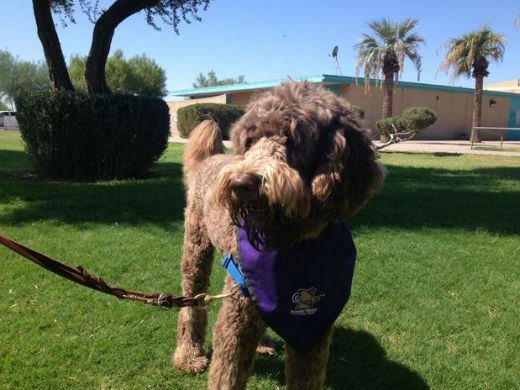by: Amanda Day
Cooper Bartholomew Howell sauntered into the kitchen, casually opened the fridge, grabbed a bottle of water and placed it on the table. It was a typical Tuesday afternoon in sunny Scottsdale, but Cooper is not a typical dog.
Rigorous Training: Who Wants to be a Professional Puppy Petter?
September is National Guide Dog Month, established in 2008 to raise funds and awareness for accredited guide dogs. Power Paws is on the forefront of training and placing guide dogs for children and adults with hearing and mobility impairments, including diabetes. Since 2001, Power Paws has certified over 70 teams and currently has more than 40 dogs in training. Despite the $22,000 dollar cost of training each dog, Carey is happy to report that “[they’ve] never had a person that really wanted a dog not get a dog.” Most dogs that go through Power Paws’ training process are bred and raised on-site. Shortly after their life begins, they are handled by a series of “puppy petters” on a daily basis so they can learn that “everything good comes from humans.” When the puppies are eight weeks old they are placed with “puppy raisers” for 18 months to two years. Each week during their training they attend a class where they learn over 90 commands that range from “sit” to “open the fridge.”
A Foundation of Friendship: Tears, Paws and Applause
Power Paws dogs are trained with love throughout every step of the way. They aren’t reprimanded or shamed, only taught with a clicker and a bounty of healthy treats. Some dogs aren’t naturally inclined to be guide dogs, Carey explains, and PP simply places them in loving homes where they can spend their life as a pet. Carey Likens the the placement process as “Match.com for dogs,” although she knows the process is deeper than filling out a profile online. Each dog’s profile is carefully filled out by five people that know the dog and matched up with a person that could benefit most from the pairing. Every six to eight weeks Power Paws introduces graduated dog matches with their prospective people, but despite the in-depth screening process, the dogs and people inevitably seem to chose one another when they meet. It’s difficult for any dog lover to imagine giving up a dog they have spent two years training and loving, but Carey assuages them with “a tissue and another puppy” on graduation day. When a dog and their forever person meet for the first time, any bittersweet goodbye is quickly overcome by the greater purpose.
Medical Benefits: More Than Man’s Best Friend
Power Paws dogs assist children and adults with hard of hearing, deafness, diabetes and mobility related disabilities. Five percent of children aged five to 17 have disabilities, and ten percent of people 18 to 64 have disabilities in the U.S., according to the Census Bureau. Power Paws believes that they deserve the right to pursue the quality of life they aspire to, and their dogs help them rise to that occasion.
The working dogs help them with everything from daily tasks we take for granted, to alerting them when the doorbell rings and even monitoring blood sugar. In fact, Power Paws’ diabetic alert dogs are able to give warning 30 minutes before a dangerous blood sugar level will show up on a meter. The dogs are trained to bow when their person’s blood sugar is dropping and give a high five when it’s spiking, and they have saved many lives this way. For children with Type 1 diabetes, the dogs can give parents much needed piece of mind, even alerting them to potential blood sugar problems in the middle of the night. Although no one knows exactly how dogs can determine blood sugar levels, pharmaceutical giant Eli Lilly is currently conducting a study in the matter. Power Paws hopes that the study will reveal a scientific connection so that they can acquire some much-needed insurance funding for the process, but in the meantime they just keep their tails wagging and their hopes high, changing lives one dog at a time.
If you are interested in becoming a volunteer puppy petter or supporter of AZ Power Paws, you can find additional information at http://www.azpowerpaws.org/.

